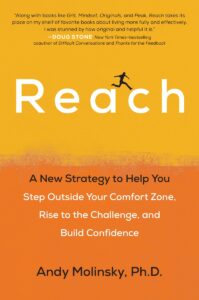Step Outside Your Comfort Zone
You may know him from his writing for the Harvard Business Review or from his features in The New York Times or The Economist. Andy Molinsky, PhD is a professor of psychology and organizational behavior at Brandeis University’s International Business School. He is the author of Reach: A New Strategy to Help You Step Outside Your Comfort Zone, Rise to the Challenge, and Build Confidence.
Since I have long been interested in helping people push past what’s comfortable, I found his new book particularly intriguing. After reading it, I am sure that you will find his work as actionable as I have. I spoke with Andy recently about his new book.
5 Roadblocks that Keep You in Your Comfort Zone
What keeps people safely ensconced inside their comfort zones?
I’ve found five specific reasons, and I call them psychological roadblocks or barriers. The first is the Authenticity Challenge: It’s the idea that acting outside your comfort zone can feel fake, foreign, and false. The second is the Competence Challenge: In addition to feeling inauthentic, you can also feel like you don’t have the ability to be successful in a situation outside your comfort zone. The third roadblock is what I call the Resentment Challenge: Even if people logically know that they need to change their behavior to be effective in a new situation, they may feel resentful or frustrated about having to stretch beyond where they’re comfortable. Roadblock #4 is the Likeability Challenge: One of the greatest worries people feel when stretching outside their comfort zones is whether people will like this new version of themselves. Finally, Roadblock #5 is the Morality Challenge: In certain instances, people can have legitimate concerns about the morality of the behavior they’re about to perform. Of course people don’t necessarily experience each of these roadblocks each time they attempt to act outside their comfort zones. However, even one or two roadblocks can be enough to keep people fully ensconced within their comfort zones.
Do most people know which one is their challenge?
When we’re afraid of something, we often just feel “worried” or “fearful.” And not really knowing or understanding where the discomfort actually comes from just compounds the problem. But what I find is that when people can apply this framework of psychological roadblocks to their lives, they have a much clearer way to make sense of their experience – and that gives them a sense of control over something that previously felt confusing or overwhelming.
Stop the Cycle of Avoidance
The vicious cycle of avoidance is one we’ve all participated in or watched to varying degrees. What’s the best way to stop the cycle and get back on the right path?
So many of us encounter this trap: We avoid something outside our comfort zone – and feel quite relieved. But then the next time around, it’s just that much harder. To stop the cycle, you have to have a deep sense of purpose that the “pain” is worth the “gain” – that whatever it is you’re contemplating outside your comfort zone will contribute to your career or personal development — or enable you to help others and make a difference. And what’s critical is that this source of conviction is authentic and meaningful to you. When you have conviction and motivation, you’ll have the power to say yes when every bone in your body is aching to say no.
Tell us more about these resources for making a difficult situation more doable.
When we face a really tough situation, we feel vulnerable, sometimes even hopeless. But the reality is that you typically have many more resources than you think to draw upon. For example, you probably have a mentor or at least someone you can go to for guidance and support. That might be someone at home or at work. And in terms of the task itself, you often also have more leeway than you think to make adjustments. If you’re fearful of public speaking, you can often visit a stage before you give a speech. You can prepare Power Point slides that capture the essence of your talk. You can even bring notes, or notecards or a lucky bracelet! And if networking is something you fear, you can adjust that setting as well, by going early or late or by bringing a colleague to the event or by choosing networking situations that are smaller and more intimate. The point is that acting outside your comfort zone isn’t a one size fits all situation. You have leeway to make it your own.
How to Build Resilience
What’s the best way to build resilience?
You’re going to encounter roadblocks as you work on stepping outside your comfort zone. It’s just inevitable. You might even be tempted to retreat right back to where it’s most comfortable. But you can weather these storms.
Think of building resilience in the way you’d build a muscle. To build resilience, you want to challenge your abilities, but not strain them. So, the first key is to find “just right” type situations to practice – where you can work on developing and honing your skills – ideally in a challenging, but not too challenging, context. You also want to ideally adopt what psychologist Carol Dweck calls a learning orientation towards the inevitable mistakes you will make, so you see them as an inevitable (and critical) part of the skill-building process, as opposed to evidence of failure. Finally, find a way to nudge yourself to continue trying whatever behavior you’re afraid of. When you have the chance to do something over and over again – even something scary – it loses some of its power over you – and this “desensitization” effect is another key ingredient in the resilience-building process.
 What are some of the mistakes we make when learning to move outside of our natural comfort zones?
What are some of the mistakes we make when learning to move outside of our natural comfort zones?
One of the biggest mistakes I find is having an unrealistic perspective on what getting outside your comfort zone is all about. And at the end of my book I detail a series of “myths” about comfort zones that people can fall prey to. For example, one myth is that, “All it takes to get outside your comfort zone is taking a leap.” But this saying is quite misleading because few people truly just spontaneously “leap” outside their comfort zones. Rather, any leap we take is typically the product of a great deal of thinking, deliberation, and courage. And when people are told to “just take a leap!” – implying that this is all it takes to step outside your comfort zone — it can feel more demoralizing than inspiring.
How do you help others learn to step outside their comfort zone?
My goal with my book Reach: A New Strategy to Help You Step Outside Your Comfort Zone, Rise to the Challenge, and Build Confidence has been to put all my very best thinking into a trusted resource people can keep coming back to. Also, as I reference in the book, I’ve created a really fun and exciting MBA course based on the book where my students apply the ideas directly to their lives. This course has been one of the most fulfilling things I’ve done — and has become the perfect living laboratory for developing and testing my ideas.
For more information: Reach: A New Strategy to Help You Step Outside Your Comfort Zone, Rise to the Challenge, and Build Confidence

